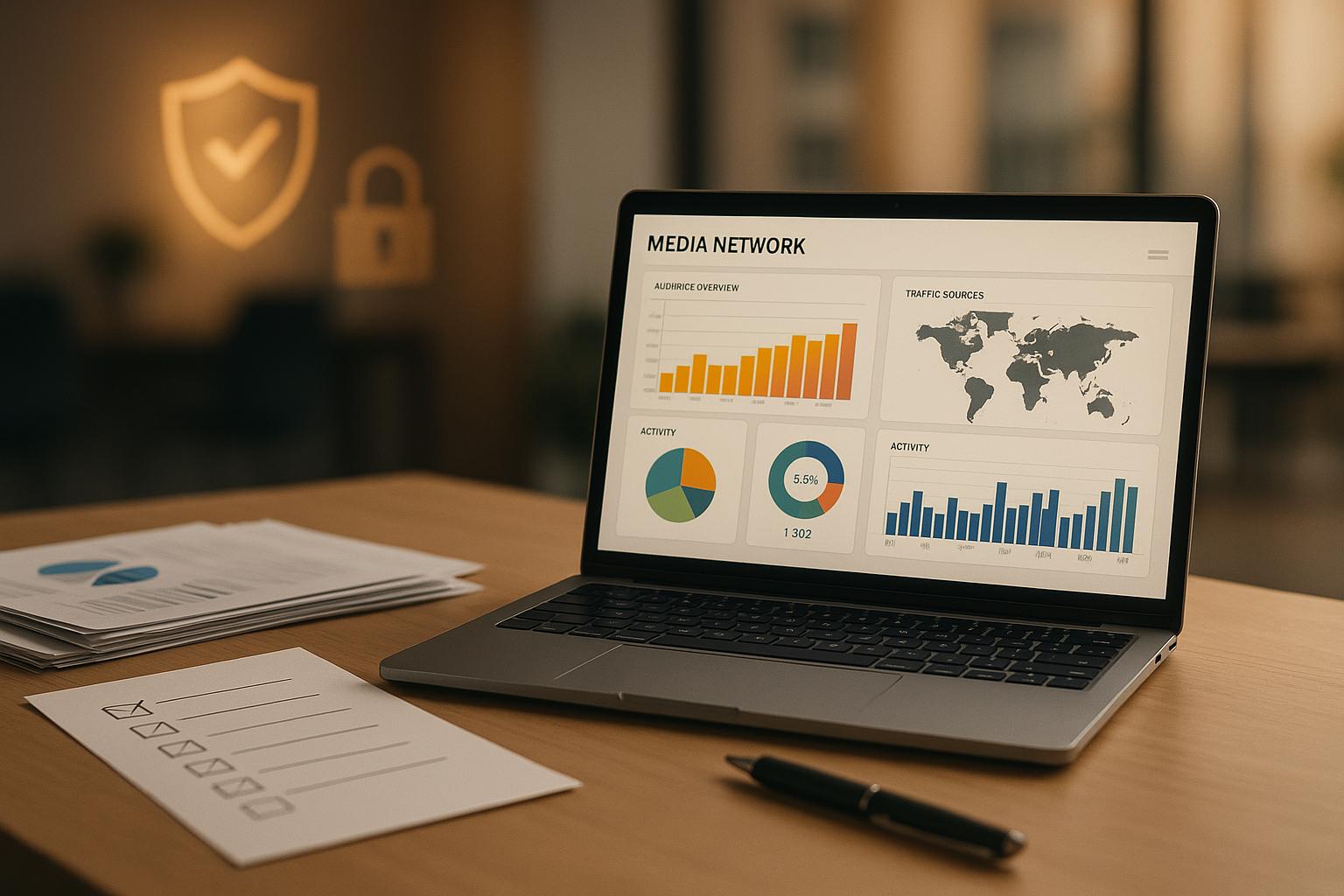Predictive analytics transforms B2B sales by using data to forecast outcomes, prioritize leads, and identify risks. Instead of relying on intuition, sales teams leverage historical data and algorithms for smarter decisions. Here’s what you need to know:
- Lead Scoring: Focus on high-potential leads based on past data.
- Revenue Forecasting: Allocate resources effectively with accurate predictions.
- Risk Detection: Anticipate issues like customer churn early.
Quick Comparison
| Key Area | Traditional Approach | Predictive Analytics |
|---|---|---|
| Lead Qualification | Manual scoring | Data-driven scoring |
| Sales Forecasting | Trend analysis | Pattern recognition |
| Risk Assessment | Reactive response | Proactive identification |
| Resource Allocation | Past performance | Probability models |
To succeed with predictive analytics, you need clean, reliable data from sources like CRM systems, historical sales, and market intelligence. The key is integrating these insights into your tools, training your team, and refining models over time. Ready to make data-driven decisions?
Required Data for Sales Predictions
Core B2B Sales Data Sources
To build accurate predictive models, you need data from multiple sources. While CRM systems are a great starting point, offering details like customer interactions, deal stages, and account histories, they alone aren't enough. For robust predictions, you’ll need to expand your data collection.
Here are the four key data categories essential for B2B sales predictions:
| Data Category | Key Components | Purpose |
|---|---|---|
| CRM Records | Contact details, deal stages, account histories | Monitor customer relationships and sales pipeline |
| Historical Sales | Past transactions, win/loss rates, revenue data | Identify patterns and set performance benchmarks |
| Customer Engagement | Email interactions, meeting attendance, website visits | Gauge buyer intent and interest levels |
| Market Intelligence | Industry trends, competitor activity, economic indicators | Factor in external influences on sales |
For deeper insights, don’t just track meeting attendance - also capture engagement details like questions asked or follow-up actions.
Data Quality Management
Once you’ve established your data sources, the next step is ensuring the quality of that data. Predictive models are only as good as the information they rely on, and poor data quality can lead to misleading forecasts. In fact, research shows that maintaining clean, reliable data is a major challenge for many organizations.
Here are some best practices to keep your data in top shape:
Regular Data Audits
Schedule routine reviews to catch issues like duplicate entries, outdated details, or inconsistent formatting. Automated tools can help identify these problems, and assigning clear data ownership ensures someone is always accountable for accuracy.
Standardization Protocols
Set clear guidelines for entering data - this includes standardizing company names, industry classifications, deal stage definitions, revenue categories, and contact formats. Consistency here is key.
Handling Missing Data
For incomplete records, use statistical methods or machine learning techniques to work with partial data. For critical fields, consider requiring mandatory data entry in your CRM system to avoid gaps.
Data Enrichment
Supplement your internal data with third-party tools like Clearbit or LeadGenius. These platforms can automatically enhance your records with additional firmographic and technographic details.
To maintain high-quality data over time, establish governance policies and provide regular training for your team. By ensuring consistent and accurate data entry, you’ll give your predictive models the reliable foundation they need to deliver precise sales forecasts.
Predictive Analytics for Sales and Marketing
Predictive Models in B2B Sales
Once you have high-quality, enriched data, the next step is to choose models that can turn that data into actionable forecasts. The effectiveness of these predictive models depends heavily on the clean, well-organized data discussed earlier.
Common Prediction Algorithms
In B2B sales forecasting, three types of predictive algorithms are frequently used:
Regression Models
These models help uncover relationships between different sales variables. For instance, they can show how marketing spend impacts deal closure rates or how customer engagement metrics influence sales performance.
Time-Series Analysis
Time-series models focus on sequential data to identify trends and patterns, such as:
- Quarterly performance patterns
- Renewal trends over the year
- Seasonal sales fluctuations
- Pipeline velocity
Machine Learning Methods
Machine learning algorithms excel at identifying complex, non-linear patterns. They can:
- Process both structured and unstructured data
- Spot intricate relationships between variables
- Continuously learn and improve as new data becomes available
- Adjust automatically to changing conditions
Data Preparation for Sales Models
To ensure accurate forecasting, raw sales data needs to be structured into key variables. Here’s how these variables contribute to predictive accuracy:
| Variable Type | Description | Purpose |
|---|---|---|
| Lead Velocity | Rate of new leads entering pipeline | Predict future pipeline volume |
| Deal Stage Duration | Time spent in each sales phase | Estimate closure timelines |
| Engagement Metrics | Patterns of customer interaction | Gauge likelihood of purchase |
| Win Rate Indicators | Historical success rates | Forecast conversion probabilities |
This organized data serves as the foundation for feature engineering and model training.
Feature Engineering
Feature engineering refines raw data into predictive variables by:
- Normalizing data to ensure consistency
- Creating composite metrics for deeper insights
- Addressing outliers that could skew results
- Defining clear measurement periods
Data Enrichment Process
Predictive models become even more accurate when enriched with additional information, such as:
- Firmographic data from third-party tools
- Market intelligence insights
- Customer engagement metrics
- Historical performance records
sbb-itb-01010c0
Adding Predictions to Sales Workflows
Incorporating predictive analytics into your sales processes can bring actionable insights straight into your CRM, making decision-making quicker and more informed.
CRM Integration Steps
| Integration Component | Purpose | Implementation Approach |
|---|---|---|
| Custom Fields | Display prediction scores | Add fields for lead scores, opportunity values, and risk levels |
| Dashboard Widgets | Visualize predictions | Create visual indicators for high-priority actions |
| API Connections | Enable real-time updates | Set up secure data pipelines between predictive tools and your CRM |
| Role-Based Views | Customize access | Configure prediction displays tailored to specific user roles |
Data Pipeline Configuration
Make sure your CRM is seamlessly connected to your predictive tools via API integrations. Regular validation of these pipelines is essential to maintain accurate and up-to-date insights.
After that, set up automated sales alerts so your team can act promptly on the predictions provided.
Setting Up Sales Alerts
Alerts based on priority ensure your team focuses on the most critical predictions first.
Priority-Based Alert Types
-
High Priority Alerts
These demand immediate attention and can be sent via mobile notifications or email. Examples include:- Opportunities showing a sudden increase in buying signals
- High-value prospects with new risk factors
- Strategic accounts signaling potential churn
-
Medium Priority Alerts
These appear within the CRM interface and might include:- Cross-sell opportunities within existing accounts
- Warnings about potential gaps in the sales pipeline
- Territory coverage alerts
-
Low Priority Insights
These are included in periodic reports, such as weekly digests, and focus on long-term trends, market updates, and performance patterns.
Alert Automation Rules
Set up your alert system to trigger notifications when predictive models detect key changes. For instance, if there’s a sudden spike in risk or a new opportunity signal, the system should alert the relevant team members. Tailoring these rules to your business needs ensures the alerts are timely and actionable.
Performance Monitoring
To ensure your alert system is working effectively, track the following metrics:
- How quickly your team responds to different alert types
- The time it takes to act on critical notifications
- The revenue impact of actions driven by alerts
- The frequency of false positives in the alert system
Testing and Improving Models
Once predictive insights are integrated into sales workflows, the next step is to evaluate and refine the model's performance. Regular assessment ensures accurate B2B sales forecasts and keeps your predictions reliable. Let’s explore the metrics and processes that help you measure and improve your models effectively.
Model Accuracy Metrics
To gauge how well your predictive models are working, it's important to track key performance indicators. Here are the main metrics to focus on:
| Metric | Description |
|---|---|
| Accuracy | Measures the proportion of correct predictions out of all predictions made. |
| Precision | Looks at how many positive predictions were actually correct. |
| Recall | Tracks the percentage of actual opportunities that were correctly identified. |
| MAPE | Calculates the average percentage difference between predicted and actual values. |
You can monitor these metrics through your CRM dashboard to identify trends and address potential issues early. For example:
- Compare predicted sales figures to actual results to assess revenue impact.
- Track conversion rate predictions at each stage of the sales pipeline.
- Observe how accuracy shifts over different forecast periods to adjust strategies accordingly.
Model Update Process
In rapidly changing markets, predictive models should be updated quarterly - or even more often if needed. Trust Insights recommends using automated monitoring systems to flag when performance dips below acceptable thresholds.
Data Enhancement Steps
To keep your models sharp, follow these steps for updating and refining your data:
- Collection: Gather new sales data, including win/loss outcomes, to ensure your dataset reflects current trends.
- Validation: Check the quality of the data to eliminate inaccuracies or inconsistencies.
- Integration: Factor in market changes and introduce new variables to improve predictions.
- Testing: Use A/B testing to confirm whether the updates lead to better outcomes.
Error Analysis Framework
When performance issues arise, an error analysis framework can help pinpoint and resolve problems:
| Error Type | Resolution Approach |
|---|---|
| Data Quality | Apply strict data validation rules and implement quality controls. |
| Market Changes | Conduct regular market analyses and adjust the model accordingly. |
| Missing Variables | Improve feature engineering to identify and include relevant variables. |
| Algorithm Limitations | Experiment with alternative modeling techniques to overcome shortcomings. |
Conclusion
Main Advantages for B2B Sales
Predictive analytics has reshaped how B2B sales teams operate, shifting decisions from gut feelings to strategies backed by data. Some of the standout benefits include more accurate sales forecasts, better use of resources, and smarter lead prioritization. These advantages allow teams to zero in on high-potential deals while spending less time chasing leads that are unlikely to close.
To fully capitalize on these benefits, having a clear and actionable implementation plan is crucial.
Implementation Guide
If you're ready to integrate predictive analytics into your sales process, here’s how you can get started:
-
Evaluate and Prepare Your Data
Take stock of your current sales data. Make sure your CRM tracks key metrics like conversion rates, sales cycle durations, and win rates. Clean up and standardize this data to ensure it's accurate and ready for analysis. -
Choose the Right Tools
Look for predictive analytics tools that work well with your existing CRM system. Seamless integration will make the transition smoother. -
Train Your Team
Equip your sales team with the skills to understand and use predictive insights. Teach them how to act on alerts and provide feedback to fine-tune forecasts. -
Commit to Ongoing Refinement
Set up regular check-ins to review and improve your predictive models. This ensures your analytics stay sharp and continue delivering value over time.
FAQs
How can businesses ensure their data is reliable for effective predictive analytics in B2B sales?
To get dependable results from predictive analytics in B2B sales, businesses need to prioritize data quality and consistency. Start by thoroughly auditing your current data to identify and address inaccuracies, duplicate entries, or missing details. Establish clear data governance practices, such as setting standards for how data is entered and scheduling regular updates to keep everything accurate.
It’s also important to gather data from multiple sources to build a well-rounded perspective. Just make sure the data stays clean and organized. Using tools or platforms with data validation and cleansing features can streamline this process, saving time and effort. Ultimately, the reliability of your predictive analytics hinges on the quality of the data you provide.
How can businesses integrate predictive analytics into their CRM systems to boost B2B sales performance?
Integrating predictive analytics into your CRM system can completely change the way your business tackles B2B sales. By tapping into data-driven insights, you can make smarter decisions and refine your sales strategies. Here’s how to get started:
- Assess your CRM and data quality: First things first, check if your CRM system is equipped to support predictive analytics tools. At the same time, make sure your data is clean, accurate, and regularly updated - bad data leads to bad predictions.
- Select the right tools: Look for predictive analytics tools that match your sales objectives and work seamlessly with your current CRM. Features like lead scoring, sales forecasting, and customer segmentation can make a big difference.
- Build and train your models: Use your historical sales data to create predictive models. These models can help spot patterns, forecast future trends, and rank opportunities by priority.
- Track and refine: Don’t set it and forget it. Keep an eye on how accurate your predictions are and adjust your models as needed to get better results over time.
When done right, predictive analytics can reveal actionable insights, sharpen your sales strategies, and help your business thrive in the fast-paced B2B market.
How do predictive analytics models in B2B sales adapt to market changes and stay accurate over time?
Predictive analytics models in B2B sales stay effective by constantly evolving with market changes. They achieve this through machine learning, which allows them to detect patterns and trends, ensuring their predictions stay relevant as the market shifts.
To keep these models accurate, businesses need to feed them with fresh, high-quality data regularly. Monitoring performance metrics is equally important to spot any potential issues early. Additionally, retraining and fine-tuning the models periodically can address changes in customer behavior, industry developments, or economic fluctuations, making sure the predictions remain practical and dependable.


